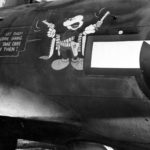Click on thumbnail images to enlarge
The Boeing/Lockheed-Vega (Vega model V-139) YB-40 Flying Fortress was a modification for operational testing purposes of the B-17F Flying Fortress, converted to act as a heavily-armed “gunship” for other bombers during World War 2.
Escort bomber YB-40 42-5925 in flight
Boeing/Lockheed-Vega YB-40 of the 92nd Bomb Group, England 1943
Escort bomber XB-40 in 1943
Rear view of a XB-40 41-24341
XB-40 41-24341 Lockheed Vega factory airfield,14 November 1942
Escort bomber YB-40 42-5741 “Chicago” from 327th Bomb Squadron, 92nd BG
Boeing/Lockheed-Vega XB-40 Bendix chin turret
Escort bomber YB-40 42-5736 named “Tampa Tornado” from 92nd Bomb Group June 1943
Left side view of a XB-40
Boeing/Lockheed-Vega XB-40 on the ground 1942
Front view of a XB-40 41-24341 1942
The Boeing/Lockheed-Vega (Vega model V-139) YB-40 Flying Fortress was a modification for operational testing purposes of the B-17F Flying Fortress, converted to act as a heavily-armed “gunship” for other bombers during World War 2.
Variants:
XB-40 – prototype converted from B-17F-1-BO 41-24342
YB-40 – 20 escort bombers converted from B-17F
TB-40 – 4 trainers converted from B-17F
Specifications:
Length: | 22,78 m (74ft 9in) |
span | 31,62 m (103ft 9in) |
Height: | 5,82 m (19ft 1in) |
Wing area: | 131,9 m2 (1,420 sq ft) |
Empty weight: | 17343 kg (38,235 lb) |
Loaded weight: | 26308 kg (58,000 lb) |
Max. take-off weight: | 28712 kg (63,300 lb) |
Wing loading | 199,4 kg/m2 (40,8 lb/sq ft) |
Max speed | 470 km/h at 7,620 m (292 mph at 25,000 ft ) |
Cruise speed | 309 km/h (192 mph) |
Range | 3635-4000 km (2,260 – 2,480 miles) |
Service ceiling | 7650 m (25,100 ft) |
Rate of climb | 2,11 m/s (416 ft/min) |
Armament | 14-16 x 12,7 mm (0.50 in) Browning M2 machine guns |
Bibliography:
- Lloyd S. Jones: U.S. Bombers, 1974
- Kev Darling: American X & Y Planes: Volume I: Experimental Aircraft to 1945, Crowood Aviation Series, 2009
- Michael O’Leary: Boeing B-17 Flying Fortress, Osprey Production Line to Frontline 2
- Martin W. Bowman: Boeing B-17 Flying Fortress, Crowood Aviation Series, 1998
- Wings Of Fame – The Journal Of Classic Combat Aircraft – Volume 6
- Rene J. Francillon: Lockheed Aircraft since 1913, 1987
- Peter M. Bowers: Boeing Aircraft Since 1916, Putnam 1989
- Alwyn T. Lloyd: B-17 Flying Fortress in Detail & Scale, Part 3: More derivatives – D & S Vol. 20










